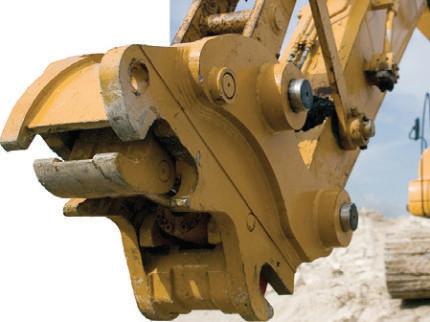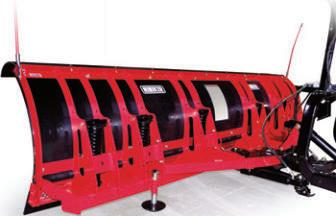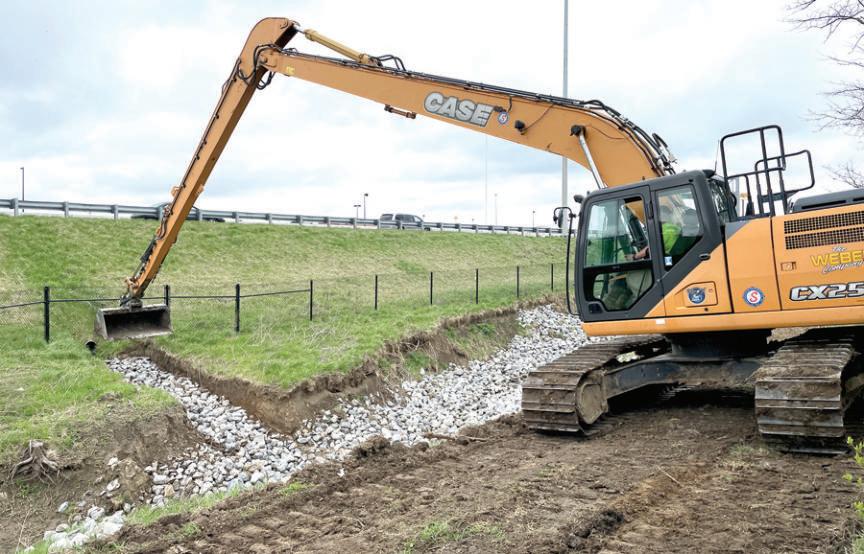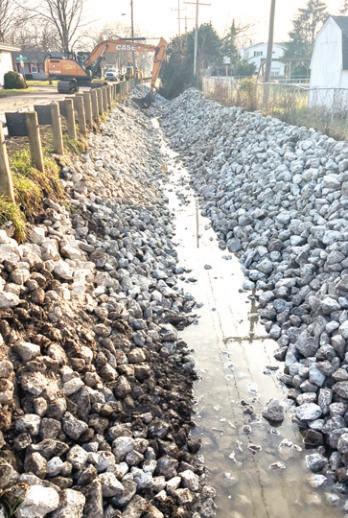
4 minute read
WERK-BRAU Buckets, Attachments
Pages 55-60S E C T I O NAttachments
For more information about these attachments and more, visit our Attachments Section on our Web site at www.constructionequipmentguide.com

Proper Tools Help Ohio Contractor Prevent Ditch Bank Erosion
Werk-Brau buckets and attachments are used all over the world, but when the project is in your own hometown … well that hits a little differently. So, when the Weber Company of Archbold, Ohio, recently embarked on a project to control erosion along a drainage ditch that ran through nearby Findlay, Ohio, Werk-Brau employees were proud to see their handiwork used to improve their local community.
The Dalzell ditch is roughly 3 mi. long and winds its way through several areas of town, including residential neighborhoods, industrial zones, commercial areas including restaurants and hotels, adjacent to Findlay High School and along Interstate 75. Weber was tasked by Hancock County with placing rip rap in roughly 2 mi. of the ditch — areas that were most susceptible to erosion as marked by county engineers. Weber crews would restructure the steeply sloped ditch banks, those with slopes approaching 2:1, to better accommodate the incoming rip rap, grooming both sides if necessary to hold the sides in place and prevent further erosion and damage.
Because of the winding nature of the drainage ditch and the extremely wet weather, which both precluded bringing heavy equipment onto the jobsites and caused further erosion that they were trying to eliminate, the project presented some peculiar challenges.
Armed with unique tools including a Case CX 250 long stick excavator with a Werk-Brau 2-yd. ditching bucket and a side dump trailer, Isaac Weber and his team made respectable progress and completed the project within their established timeframe.
Weber and his team began the project in early November. Starting in the residential areas posed some challenges as well as some opportunities. Since there was no place to stockpile material, they were running it in as needed, day by day, which was a challenge as the Carey Quarry was about an hourand-a-half round trip from the job site.
While awaiting the next trailer load of rip rap, excavator operators would distribute the rock as needed, shoring up or restructuring the ditch sides as required.
The side dump trailer allowed Weber crews to accomplish 40-ft. of the project at a time, helping them to average roughly 400 to 500 ft. per day depending on how fast they could get rock from the quarry.
After the ditch wound its way out of the residential areas where the side dump trailers were no longer feasible, Weber crews stockpiled material and moved it with a John Deere 624P wheel loader equipped with a 3.5-yd. bucket. The loader would dump a load of rip rap into the ditch, favoring whichever side was being shored up at present. They would then go back for another load while the excavator distributed the rip rap along the ditch banks. A trio of excavators were used on the project — a Case CX130, a Case CX210 and a Case CX250 — all fitted with Werk-Brau quick couplers and buckets.
“We trust Werk-Brau products. When I see that logo, I know I’m getting a high-quality, durable product that will do what it was designed to do,” said Weber.
Stockpiling materials kept the excavator and loader operators busy, but tight confines and space constraints required creativity in certain areas.
“We had a spot where the ditch ran in between the back yards of houses, so there was nowhere for an excavator to go,” said Meyer. “So, we built a ramp out of rip rap and drove the loader down there and dumped a bunch of stone. Then we brought in the Case CX130C excavator and placed it on the sides.” While not ideal, the scenario worked … for the most part. “He did have a rock get caught in the track, and then it walked the track off in the ditch,”said Meyer. “That was a pain. We put a load of rock in his bucket, extended his arm way out so that he was just traveling on one track, and he onetracked it out of there.” Meyer had another Case CX 210 excavator pulling the CX130C to keep the limping excavator moving straight. He laughs about it now but said that it was “a nightmare” at the time. The smaller CX130C and CX210 excavators were viable choices in many sections, but Meyer remembers one area where the long reach of the Case CX 250 long reach was essential.

A trio of excavators were used on the project — a Case CX130, a Case CX210 and a Case CX250 — all fitted with Werk-Brau quick couplers and buckets.











